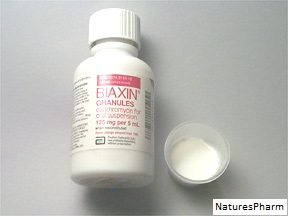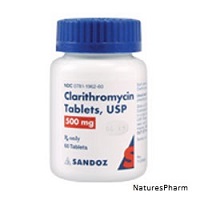What is Biaxin?
Biaxin is a trading name of the active ingredient Clarithromycin. This is an antimicrobial product of the broad action. It is a representative of the group of macrolides and is similar to erythromycin by its molecular structure. But unlike erythromycin, Biaxin has a high acid-resistance, is not destroyed in the acid of the gastro-intestinal tract, and due to this it has a higher bioavailability.
Recommendations for Use
The pharmacological functions of Biaxin are higher than in many macrolide antibiotics, and therefore Biaxin is recommended as a basic product in the first line of the antibacterial therapy. The pharmacological action of Biaxin is characterized by the bacteriostatic mechanism on the intracellular and extracellular agents. After the use of the drug, its active ingredient Clarithromycin is quickly absorbed into the systemic blood flow and is spread through the tissues and organs. In case of the interaction with pathogenic microflora, Biaxin breaks the nutrition functions of bacteria, so that they lose the activity and stop replicating.
A therapeutic effect of Biaxin is felt in 2-3 days after the started treatment. Patients have a decrease of the infection symptoms and an improvement of the general well-being.
Biaxin may be used during different inflammatory diseases of the infectious origin:
- Laginrit, pharyngitis, sinusitis, otitis media, bronchitis, pneumonia, atypical pneumonia and other diseases of the respiratory tract and ear, nose and throat.
- Stomach ulcer and duodenal ulcer when helicobacter pillory is found
- Mycobacteriosis
- Purulent skin and soft tissue infections, including folliculitis, furunculosis, wound infection
- Chlamydia and other infections of the genitourinary system, including sexually transmitted diseases.
In what dose is Biaxin used?
Biaxin may be used by adults and children over 12 years old. A daily dose and term of the treatment depends on the infection severity.
- Biaxin is not prescribed patients under 12 years old
Biaxin is mainly well tolerated, and seldom causes side effects. Even if the side effected occurred, they are related to the digestion system: diarrhea, nausea, heartburn, and stomachache. In some cases, the use of Biaxin may cause headache, sleep disorder, or skin rash.
- If light forms of the infectious diseases at incipient stage, Biaxin is used in the dose of 250 mg 2 times per day within 6-10 days
- If severe infectious processes, Biaxin is used in the dose of 500 mg 2 times per day within 7-14 days
In rare cases, a dose may achieve 2 g per day. A patient takes a loading dose of Biaxin 1000 mg 2 times per day in the first 2 days, and then a dose is reduced, and the treatment goes on the standard scheme.
Every tablet of Biaxin should be swallowed and taken with water. You may the medicine both before, and after meals. But do not chew and do not mix Biaxin with food.
Patients with intensive pathologies of kidneys or liver should take Biaxin in a lower dose of 250 mg 1-2 times per day but not more than 10 days.
Precautions
- If chronic diseases of liver, it is necessary to control the enzymes of serum in the blood
- Biaxin is not used during pregnancy. In rare cases, this antibiotic may be prescribed for the treatment of infections in pregnant women but only under doctor’s supervision
- If a woman has to take Biaxin during lactation, stop the breast feeding for a while
- Take Biaxin as long as you doctor has said. The symptoms of the infection often pass in 4-5 days but do not stop taking Biaxin. If the activity of all bacteria is not completely blocked, outbreaks of the infection may appear after the premature ending of the therapy
Side Effects
But if the daily dose of Biaxin is exceeded, the side effects may grow.


